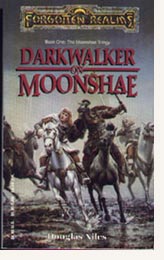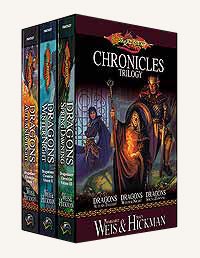| |




|
 |
 |
 |
 |
The Fiction of Gaming
|
 When the
Forgotten Realms first propelled itself into gaming greatness, it did so based on a number of very cool articles in Dragon Magazine written by the Old Sage himself, Ed Greenwood. And while these articles certainly served to energize the gaming community, it was actually a series of novels by
Douglas Niles that started to launch the game to great commercial success. When the
Forgotten Realms first propelled itself into gaming greatness, it did so based on a number of very cool articles in Dragon Magazine written by the Old Sage himself, Ed Greenwood. And while these articles certainly served to energize the gaming community, it was actually a series of novels by
Douglas Niles that started to launch the game to great commercial success.
The Darkwalker trilogy was a big hit, followed up soon after by the start of
Bob Salvatore’s
Drizzt saga. It was a huge success, but it also illustrated an important difference between gaming fiction and tabletop gaming. And where the Forgotten Realms thrived, Dragonlance failed.
The Forgotten Realms premise was that it could be all things to all people; that no matter what story you wanted to tell, the Realms was big enough to handle it. An avalanche of gaming products and novels proved this point, and Realms fans continue to thrive within the crystal sphere of this gaming giant. It’s that good.
 Dragonlance changed the pace by telling the big story; the one over-arching event that dwarfed everything else in its path. This made for a tremendous book line that has consistently hit the NY Times Bestseller’s list time and time again.
Margaret Weis and
Tracy Hickman became superstars. Dragonlance changed the pace by telling the big story; the one over-arching event that dwarfed everything else in its path. This made for a tremendous book line that has consistently hit the NY Times Bestseller’s list time and time again.
Margaret Weis and
Tracy Hickman became superstars.
The gaming side of Dragonlance has remained stalled over the years. The telling of the big story in the book line seemed to drive gamers elsewhere. After all, who wanted to play in a game world where the big story had already been told (or was still in the process of being written)? Each promising start of the Dragonlance game line soon sputtered and dwindled off.
This give and take between writing great stories and crafting workable roleplaying worlds is more Art than science. Novel writers want—need—to tell epic stories that draw the reader into the world. Game designers want—need—to portray epic worlds ripe for change by heroes. Both need to work together to achieve their goals; both are somewhat at odds with each other.
Working together with others in the mutual sandbox of a shared world can be an arduous series of give and take, with author trying to reveal secrets and designers trying to craft truly epic storylines that aren't solved in the novel. It’s tough, sometimes agonizing work, but the end results of well crafted worlds and well-written novels are self-evident, both in terms of monetary gains and pride in one’s work. Authors don’t need to win a Pulitzer for a piece of game fiction to feel good at what they’ve done. Designers don’t need to win the Origins Award to feel that they’ve accomplished something worth playing.

You can view all of the previous columns by clicking
here.
|
|


